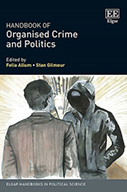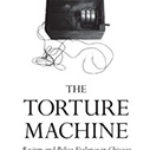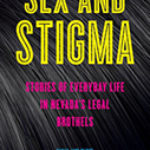Handbook Of Organised Crime And Politics

Editors: Felia Allum and Stan Gilmour
Publisher: Cheltenham, UK: Edward Elgar Publishing, 2019. 505p.
Reviewer: Jay Albanese | September 2020
Organized crime has always had a strong relationship with politics, although the direction has never been entirely clear. Does organized crime exploit politicians and the political system, or is it the other way around? This edited volume of 30 chapters is aimed to address questions like this, taking a geographical approach. Its 30 chapters are grouped into five sections, covering Europe, The Americas, Africa, Eurasia, and international organizations.
What first strikes the reader is the number of chapters written by leading writers and researchers in the field. Dwight Smith on organized crime and enterprise, Margaret Beare on corruption in Canada, Mark Shaw on South Africa, Jana Arsovska on the Western Balkans, and Matti Joutsen on the role of the United Nations, are examples.
Of course, the approaches taken in the 30 chapters differ, but each examines the linkages between organized crime and politics, policy, and the political system. The Italian mafia (Camorra) is examined in the book’s Foreword (Giuseppe Borrelli), illustrating the power held by mafia groups there is stronger than in many other places, making the mafia a predator that victimizes politics. But is it also recognized that the relationship might actually be trilateral: politics, organized crime, and business. Indeed, it is difficult to find examples of ongoing organized criminal enterprises surviving without entailing corruption and/or exploitation of both politics and business. As Borrelli suggests, “The businessman pays bribes, both to political figures and to the mafia; the former in order to obtain contracts and the latter to rule out any possibility of competition from other companies.” (p.xvii).
The Handbook’s contents overall are “concerned with the space and meeting point between criminal organisations and politics” (p.3). The chapters are research-based, and summarize and assess the evidence regarding these meeting points in different countries. There is significant historical material, which is necessary to place the political-organized crime relationship in context.
There is a lot to recommend in this book. In addition to its broad global scope, and distinctive focus on political connections, it also raises important questions, such as the “grey area” players that bind illicit relationships: the accomplices, enablers, and facilitators. These go-between actors are crucial to forming the ties that exist among business, organized crime, and politics. Depending on the situation and local circumstances, these go-betweens are sometimes characterized as corrupt businesspersons, organized crime figures, or corrupt public officials. In other cases, it is simply “business as usual,” when the rule of law does not effectively govern the transactions between the public and private sectors of the economy.
There is a great deal of content in this lengthy handbook, but it is organized well. Part I addresses Europe, with nine chapters addressing France, Sweden, Germany, Italy, Western Balkans (focusing on Albania and Serbia), Ukraine, Bulgaria, Post-Soviet Eurasia, and Russia. Part II addresses the Americas in seven chapters, focusing on the US (2 chapters), Canada, Mexico, Brazil, Guatemala, and Colombia. Part III focuses on Africa with separate chapters on Kenya, North Africa (focusing on Morocco and Mali), South Africa, and Nigeria. Part IV addresses Eurasia with chapters on Australia, New Zealand, India, China, Malaysia, and the Pacific Islands. Part V includes three chapters on international organizations: the European Union, the Financial Action Task Force, and the United Nations — describing their efforts to be more effective in terms of policy and practice against organized crime, and the role of politics in this process.
There are a number of noteworthy highlights across the span of the 30 separate chapters. The mix of countries and regions represented in the Handbook provide the reader with many questions to be considered. The historical and cultural differences among countries are clearly related to their current situation involving the presence of organized crime, as are the levels of corruption in public and private life, geographic proximity to political conflict, public demand for various illicit goods and services, and the historical relationship between local governments and organized crime.
In Bulgaria, for example, political elites have used organized criminals to carry out illicit tasks. In Mexico, a reciprocity exists between political actors and organized crime with some striking similarities in Guatemala, Malaysia, and elsewhere. In South Africa and Nigeria, an analogous situation exists, but there are important differences reflecting variances in local history, political conflicts, the local situation for the supply and demand for various illicit goods and services, and effectiveness of the rule of law. It is up to the reader to make these transnational connections, but a motivated student or researcher can find much insight, and new hypotheses to test, with a careful reading of this edited volume. As noted in the last chapter on United Nations efforts, the last 20 years has “secured major successes” in gaining global consensus and the first binding international agreements (Conventions) on the nature and seriousness, and the tools and procedures, required to address both organized crime and corruption. (p.479). But progress toward implementation has been slow. The recently adopted implementation mechanism (2018) at the UN involves peer review of countries to assess their adherence to the criminalization, enforcement, prosecution, adjudication, and prevention requirements of the Convention, in order to assess the extent to which State parties have been fulfilling their binding obligations. It is hoped that peer review will place pressure on governments that have been slow to move against organized crime.
Perhaps the most important contribution of this Handbook is the clear message that studies and policies addressing organized crime cannot overlook the political environment in which they exist. History and culture play large roles, but politics can either enhance or doom even the best efforts to reduce the influence of organized crime.
In sum, the Handbook of Organised Crime and Politics is a useful addition to your library in addressing the unique angle of political connections to organized crime, coverage of large portions of the world, inclusion of many well-known researchers as chapter authors, and its strong historical approach in making sense of the current global situation.
Jay Albanese, Wilder School of Government & Public Affairs, Virginia Commonwealth University


